Description
- [Wide Application] 800Wh daily output depends on the 4 hours sunlight availability; suited for applications that require a smaller footprint, making it a favorite for those with RVs, campers, caravan, boat, Green house and more
- [Excellent Performance] 22% High solar cell efficiency; Corrosion-resistant aluminum frame for outdoor use, allowing the panels to last for decades as well as withstand high winds (2400Pa) and snow loads (5400Pa)
- [Multiple Protection] The Renogy Adventurer-Li 30A PWM charge controller is designed for aesthetically clean flush mounting on RV or camper walls; Protection against: overcharging, overload, short-circuit, and reverse polarity
- [Easy Installation] Pre-drilled holes and Plug&Play cables on the back allow for fast mounting, and it supports lithium batteries, lead-acid batteries, gel batteries; 3 pairs of Y branch connectors are newly added to meet your parallel requirements
- [Warranty] 5 year warranty and 24/7 technical support team.
- Protection Degree: IP67, mated ; Temperature: -40°F to +194°F
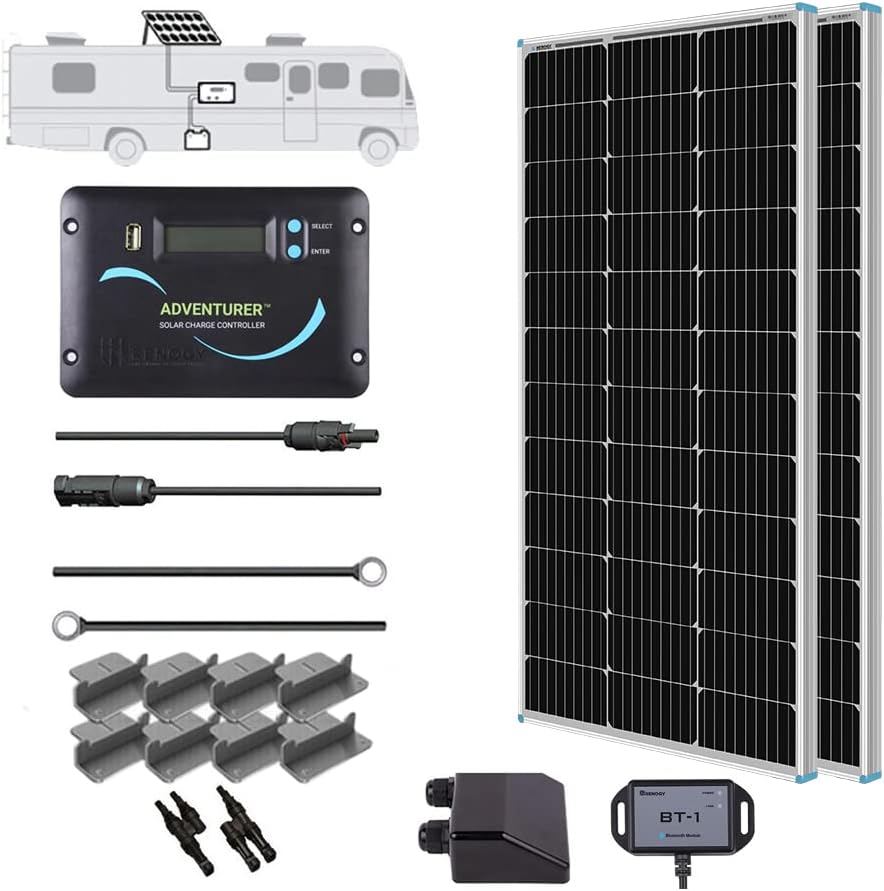


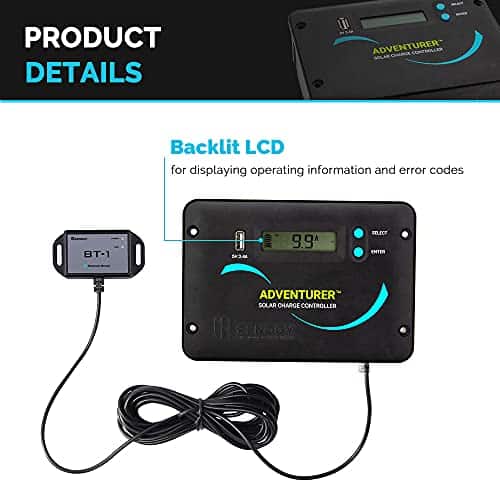
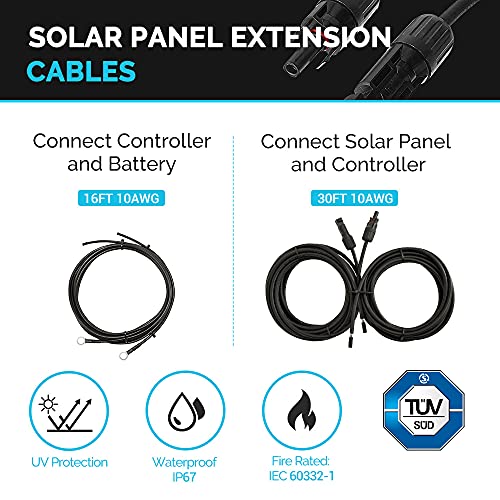
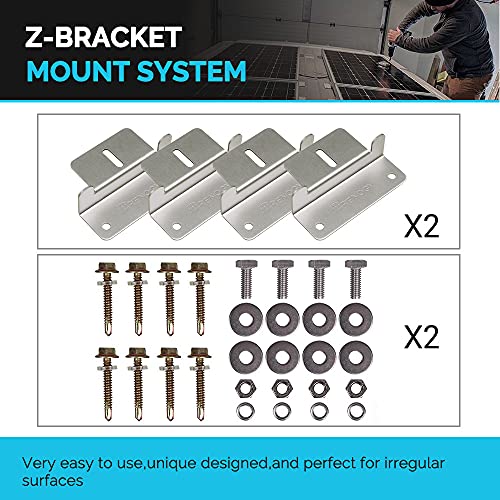
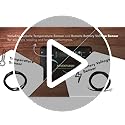
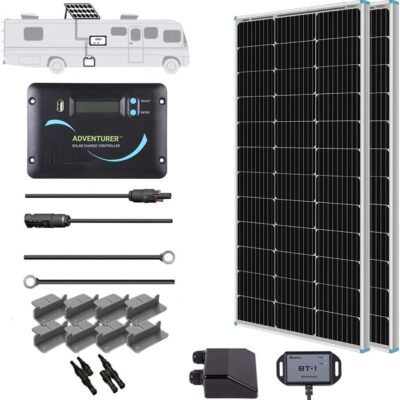

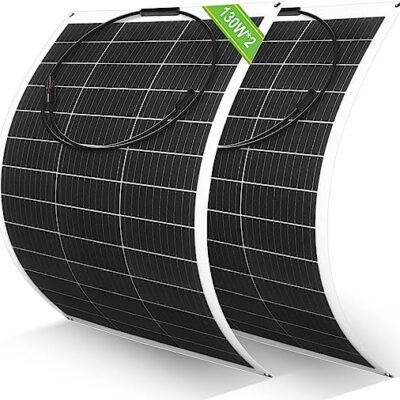
Amazon Customer –
My husband and I really like this solar kit. They make it easy to install. The connectors are done in male and female connectors for ease for where to go. Unless you put them not in a different order. Once my husband and I fixed the correct order the solar worked perfectly.
DR –
This kit is well made. All the hardware is either aluminum or stainless steel (no plated screws or fasteners). The cables are 10 gauge tinned copper and have thick insulation that looks likely to last a long time.
My only issue is with the voltage controller design. If you surface mount the unit you cannot hide the wires. The wires have to come from below to fit into the terminals. Also, if you want to disconnect a wire you have to take the unit off the wall to access the screws on the terminals. Not the best design choice for terminals.
If you recess mount the controller this will not be an issue.
It would have been nice to have some weather resistant zip ties included in the kit. Get stainless cable clamps with rubber protectors and some UV and weather resistant zip ties for your install – it will help.
Shawn –
Easy install. Cables are quite long so I was able to easily run them into the trailer and to the battery. The controller comes with a USB charge port which has been a really nice touch. Enough to keep batteries at 90-100 most of the time with average use and a few hours of direct sunlight on them.
Steve –
I wish I would’ve went with his system from the beginning. I purchased the 200 watt system. After getting everything figured out and installed this system has been running on its own in my driveway in a test mode now for over a week. I’ve been running a medium sized portable 55qt. refrigerator set at 30 degrees on 12v continually, and an exhaust fan (during the day only) plugged into the auxiliary outlets that I have rewired to run on the auxiliary batteries. It is able to keep up with the fan running on high, and the refrigerator in direct sunlight throughout the day. The app showed 100% battery level during peak sunlight. This is fantastic for me because I want to be off the grid while camping. I would highly recommend this system for an entry level RV addition. Don’t waste your time with harbor freight solar panels or any of that junk they sell. It was a big waste of money for me. That junk left me with a dead battery on my van with my previous setup. You get what you pay for came to mind. So I went all out to build a independent system to power all my needs while camping. All the parts you need to swap your E series Ford van you can get on Amazon. I installed a switch to connect the auxiliary batteries to the vans main battery to recharge in a pinch, this was a great addition as a back up as most RVs have this in their system anyway. The battery boxes are for the diesel version of E350 found on Ebay. The batteries you can get for almost half price at Costco. I supplied some photos of what I did. It works great bottom line! I got everything in the box from Renogy as promised, not as some have complained about in their reviews. Plenty of cable is supplied to do just about everything you need. The Bluetooth app is a welcome edition. Great job Renogy!
Steve –
I put the solar on the roof of my 2018 rv with a new 200 amp renogy battery
hard part was deciding witch way to get the cables from the roof to the adventure controller
I like the app and I put in the battery temp cable. so far very happy with it.
installed june 2024
Ben Anderson –
Installed 2 days ago. First advise…. READ EVERYTHING FIRST! including the full manual available from Renogy website as this does not come with the kit. I did notice this in a few other reviews as well.
Pro – Kit was fairly easy to install once directions are full understood.
Pro – Kit comes with more than enough wire for the install on my Jayco 212QB
Pro – It was unclear in the Amazon description weather or not the BlueTooth module was included as it sort of made it look like an add-on option. Good news this kit does include this module and it works very well. I would say this module is a MUST HAVE.
Con – My kit was already opened by another customer. One solar panel was dirty and one bag of wiring was opened and repackaged. I paid for a brand new kit not a kit that was recycled.
Con – As mentioned READ EVERYTHING. It is mentioned 4 times in the install manual that you MUST have a battery connected to the charge controller BEFORE attaching the leads from the solar panels. BUT there is no way other than climbing onto the roof and manually disconnecting the solar panels at the connectors to disconnect solar supply when changing a battery or disconnecting a battery for long term storage. If a user MUST connect a battery before solar panels are hooked up why does the charge controller not have an on/off switch or have a inline switch a user can mount themselves. I got around this by routing the solar panel leads through the exterior refrigerator access panel and mounting a switchable circuit breaker there. I have a tag on my battery leads reminding me or perhaps a repair tech of the need to turn off solar system before disconnecting battery.
Con – no fasteners or even suggestions to secure wiring to roof. I ended up wrapping my wiring in a flexible conduit and fastening to A/C housing before sneaking into the refrigerator roof vent.
Hope this helps. All of this known I would buy again and might still add 2 additional panels if ever needed.
Steve
Steve Bogdon –
Battery cables both black.
Spring Creek Urban Homestead –
8/28/19 Update
We used our system for a 10 day camping trip to Glacier National Park and other areas. We were very impressed. Each day our batteries were charged; some days fully and other days partially. With that said, we left the popup camper every morning for adventures and returned in the evenings. Some days were cloudy. We also were around trees and camping in the mountains… so I don’t know how much of the day the sun was even shining on the panels. While I doubt I will ever recoup my cost in electricity savings (using the camper 10-14 days a year) I am already very happy with the performance of the solar system. It kept us with power (to charge camera batteries, phones and laptops) during a 10 day trip without ever plugging into the grid for electricity!
Early July (first impression):
This is a first impression. Wow!!! The package was as promised and very easy to set up. I plan to do an update after we have used it for a while. Please note that I upgraded it a bit by purchasing the inline fuses and upgraded the controller. I wish we had tried a solar package before this.
Amazon Customer –
Just finished installing this kit. It was an easy install after downloading and reading the PDF instructions. It’s fairly intuitive anyway. Plenty of wire length for the install, although I installed this kit on a slide in truck camper. After hooking everything up on a sunny hot day (3,800 feet elevation in high desert) the charge controller was reading “PV array voltage 16.1V, charging current 7.4A”. I used 2 flooded acid RV battery’s hooked up in parallel for a 12V system. I haven’t stressed the system yet and will update after some use. A couple recommendations: (1) Make sure to hook up the battery to the charge controller FIRST !! (2) Don’t forget to install 30 amp fuses, not included. (3) I recommend installing 2 heavy duty on/off switches. One to disconnect the battery, and one to disconnect the solar panels (through the positive + wire).
Spring Creek Urban Homestead –
This solar package is made of durable good quality panels and control panel with all the parts to assemble and use
Iron Clad –
I took the time ti install the control panel flush in the wall and run all of the cables in loom and tied them all up ect. Intall was fairly straightforward and simple. I even upgraded from o e battery to 3 as i already had them laying arou d from a recent trade. So very happy to see that they work as advertised. The two panels in direct sunlight were producing about 140w, that’s about the expected max.
The controller seems to function as it should regulating the input (upwards of 20v) to about 13v charges rate and managing the batteries. It does however always say the controller is 77°, so there is something wrong there. The Bluetooth is crap. The app is awesome when it works. I have to remove the device in the app and re-add it EVERY TIME I want to connect and see the Info. That’s my biggest issue with the system.
I have just one panel set up while the camper is parked to maintain the batteries and seems to be doing the job just fine.